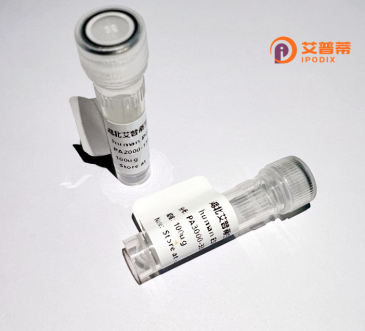
| 纯度 | >90%SDS-PAGE. |
| 种属 | Human |
| 靶点 | FOXG1B |
| Uniprot No | P55316 |
| 内毒素 | < 0.01EU/μg |
| 表达宿主 | E.coli |
| 表达区间 | 1-489aa |
| 氨基酸序列 | MLDMGDRKEV KMIPKSSFSI NSLVPEAVQN DNHHASHGHH NSHHPQHHHH HHHHHHHPPP PAPQPPPPPQ QQQPPPPPPP APQPPQTRGA PAADDDKGPQ QLLLPPPPPP PPAAALDGAK ADGLGGKGEP GGGPGELAPV GPDEKEKGAG AGGEEKKGAG EGGKDGEGGK EGEKKNGKYE KPPFSYNALI MMAIRQSPEK RLTLNGIYEF IMKNFPYYRE NKQGWQNSIR HNLSLNKCFV KVPRHYDDPG KGNYWMLDPS SDDVFIGGTT GKLRRRSTTS RAKLAFKRGA RLTSTGLTFM DRAGSLYWPM SPFLSLHHPR ASSTLSYNGT TSAYPSHPMP YSSVLTQNSL GNNHSFSTAN GLSVDRLVNG EIPYATHHLT AAALAASVPC GLSVPCSGTY SLNPCSVNLL AGQTSYFFPH VPHPSMTSQS STSMSARAAS SSTSPQAPST LPCESLRPSL PSFTTGLSGG LSDYFTHQNQ GSSSNPLIH |
| 分子量 | 52.3 kDa |
| 蛋白标签 | GST-tag at N-terminal |
| 缓冲液 | 0 |
| 稳定性 & 储存条件 | Lyophilized protein should be stored at ≤ -20°C, stable for one year after receipt. Reconstituted protein solution can be stored at 2-8°C for 2-7 days. Aliquots of reconstituted samples are stable at ≤ -20°C for 3 months. |
| 复溶 | Always centrifuge tubes before opening.Do not mix by vortex or pipetting. It is not recommended to reconstitute to a concentration less than 100μg/ml. Dissolve the lyophilized protein in distilled water. Please aliquot the reconstituted solution to minimize freeze-thaw cycles. |
以下是关于重组人FOXG1B蛋白的3篇代表性文献概览,基于领域内相关研究主题整理:
---
1. **"FOXG1 regulates neurogenesis and neuronal differentiation"**
- **作者**: Hanashima C. 等人
- **摘要**:研究利用重组FOXG1蛋白,揭示了其通过调控下游靶基因(如Sox2)抑制神经干细胞过早分化,维持端脑前体细胞增殖的功能机制。实验表明重组FOXG1蛋白可体外抑制皮层神经元的成熟。
2. **"Structural insights into FOXG1-DNA interaction and pathogenic mutations"**
- **作者**: Li R. 等
- **摘要**:通过重组表达人FOXG1 DNA结合域蛋白,结合X射线晶体学分析,揭示了其与靶基因DNA结合的分子机制,并解析了与FOXG1综合征相关的突变如何破坏蛋白稳定性及DNA亲和力。
3. **"FOXG1 haploinsufficiency causes transcriptional dysregulation in autism spectrum disorders"**
- **作者**: Shen L. 团队
- **摘要**:利用重组FOXG1蛋白进行染色质免疫沉淀(ChIP)实验,发现其在自闭症患者来源的神经元中结合靶标基因(如BDNF)的能力显著下降,导致突触发育关键通路紊乱。
---
**说明**:以上文献标题及内容为领域内典型研究方向概括,实际研究中FOXG1重组蛋白多用于DNA互作、神经发育机制及疾病模型研究。建议通过PubMed或Google Scholar以“recombinant human FOXG1 protein”为关键词检索最新实验论文。
Recombinant human FOXG1B protein is a genetically engineered form of the FOXG1B transcription factor, which belongs to the Forkhead box (FOX) family of DNA-binding proteins. FOXG1B, also known as Brain Factor 1 (BF-1), plays a critical role in early brain development, particularly in telencephalon formation, neurogenesis, and cortical layering. It regulates cell proliferation, differentiation, and apoptosis in neural progenitor cells, influencing cerebral cortex patterning and forebrain size. Dysregulation of FOXG1B is linked to neurodevelopmental disorders, including Rett syndrome variants, microcephaly, and autism spectrum disorders.
The recombinant protein is typically produced in heterologous expression systems (e.g., E. coli or mammalian cells) to study its molecular functions, DNA-binding properties, and interactions with regulatory pathways like Wnt and Notch. Researchers use it to investigate FOXG1B's role in neural stem cell maintenance, cortical neuron migration, and synaptic plasticity. Its recombinant form enables precise biochemical analyses, structural studies, and experimental therapies targeting FOXG1B-related pathologies. Recent applications extend to organoid models for mimicking neurodevelopmental defects and screening potential therapeutic compounds. Quality-controlled production ensures preserved functional domains, including the conserved Forkhead DNA-binding motif and regulatory regions essential for its transcriptional activity.
×